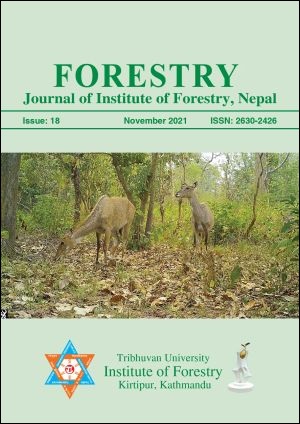Dynamics of Land Surface Temperature in Response to Land Use Land Cover Change in Phewa watershed, Kaski, Nepal
DOI:
https://doi.org/10.3126/forestry.v18i01.41758Keywords:
Land Use Land Cover Change, Land Surface Temperature, Phewa watershed, Landsat, SupervisedAbstract
Geospatial tools play an important role in monitoring Land Use Land Cover Change (LULCC) and Land Surface Temperature (LST). This study assessed the extent of LULCC during 1990, 2007 and 2020 using temporal satellite imageries, and estimates LST during the study periods in relation to LULCC and explores various adaptation practices adopted in response to LST change in Phewa watershed. Landsat imageries were used for LULC classification and LST estimation. Purposive household survey (N=150), key informant survey (N=4), focus group discussion (N=4) and direct field observations were carried out to explore various adaptation practices. LULC maps was generated by using supervised classification followed by post classification change detection technique for LULCC analysis. Agricultural land and urban areas were found to have increased by 6.6% and 0.32% respectively while forest area, barren land and water bodies were found to have decreased by 1.88%, 4.41% and 0.63%, respectively, between 1990 and 2007. Forest area, urban areas and barren land had increased by 5.54%, 1.32% and 1.48%, respectively, while agricultural land and water bodies were observed to have decreased by 8.2% and 0.13%, respectively, between 2007 and 2020. The mean LST were 22.59° C, 22.81° C and 24.56° C in March-April and 14.65° C, 14.97° C and 15.27° C in January-December, respectively. Urban areas and water bodies exhibit highest and lowest mean values of LST, respectively, during study periods. LULCC due to urban growth and infrastructural developments had contributed to increase in LST. The highest rank to adaptation practices were for changes in cropping patterns and species, followed by agroforestry, use of improved seeds, shift to other income generation activities, use of more fertilizers, irrigation practices and growing vegetables in poly house which were statistically significant. This study provides scientific insights for policy makers and urban planners in improving urban planning and management.
Downloads
Downloads
Published
How to Cite
Issue
Section
License
© Tribhuvan University, Institute of Forestry




